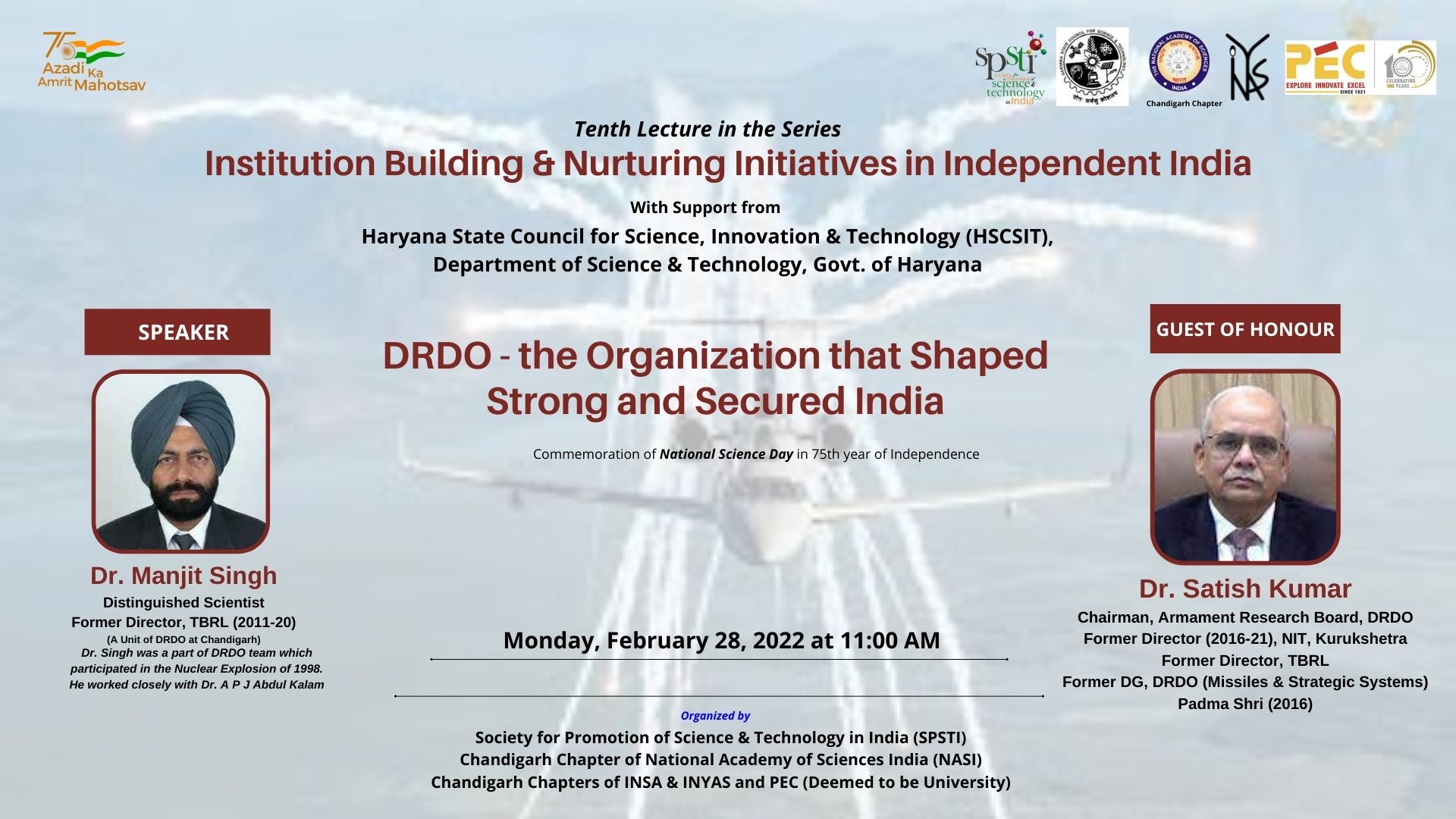“The Glorious History of DRDO Traced”
Atulya, Aslesha, Revathi, Rajendra, Swathi, Pinaka – is that the roll call of a class of students? Roll-call it is, but that of a deadly kind; these are but some of the names from the catche of sophisticated world-class weapon systems developed by the Defence Research and Development Organization (DRDO) in just 62 years of existence. This journey was traced by Dr. Manjit Singh, former Director of TBRL (Terminal Ballistic Research Laboratory), a lab belonging to the DRDO system, which today has about 50 Research and Development laboratories spread all over the country, catering to different aspects and needs of the organization. DRDO is a household name today largely because of its association with Missile Man Dr. Abdul Kalam, Bharat Ratna.
Dr. Singh Delivered the 10th lecture in the series “Institution Building and Nurturing Initiatives in Independent India” initiated by the Society for Promotion of Science and Technology in India (SPSTI)to commemorate Azadi ka Amrit Mahotsav. These lecture are being held in association with Chandigarh chapters of the science academies NASI, INYAS and INSA and are supported by the Haryana State Council for Science Innovation and Technology. The lecture, a spellbinding one was delivered on February 28, 2022, at 11.00 am, online via zoom platform and the Facebook page of SPSTI. The other eminent defence scientist present on the occasion was Dr. Satish Kumar, the guest of honour. Dr. Kumar, a Padma Shree and a much decorated scientist, himself earlier Director, TBRL, has been the mentor of Dr. Singh, himself very accomplished in the area of warhead system development. According to him, credit goes to national leaders in the early days of newly independent India to translate into action their thinking that to be self-sufficient India needs scientific development in multiple directions including Atomic Energy, Space and defence technology. Balasya Mulam Vigyanam – the source of strength is Science – is the Motto of today’s DRDO.
Carrying this thought forward, Dr Manjit traced the establishment of an elaborate and effective Defence Labs system starting from just 18 ordinance factories in 1947, which had been set up to contribute to the Ist and IInd world war efforts of British Govt. ! Today DRDO consists of 50 labs devoted to developing a plethora of technologies and processes. Some of the well-known scientists who helped build up the system were Dr D. S. Kothari (the first Chairman of UGC) who became the Scientific advisor to the PM (there was no defence ministry then) and refused the full salary of secretary to the govt., preferring to remain at professors scale. This was 1948. In 1961 he went back to being a Professor and Chair UGC and was followed by a succession of other stalwart Physicists Bhagavantam, B. D. Nagchaudhury, M. G. K. Menon and Raja Ramanna who left the position of Advisor to Raksha Mantri in 1980. The DRDO was formed in this duration, 1958, as an amalgamation of three organisations – Defence Science Organization (DSO), Technical Development Establishment and Directorate of Technical Development &Production. Gradually the number of labs rose and so did production. In the 1980 – 90 decade the production value rose from 105 crores to 2025 crore; further, by 1999 during Kalam’s time, it rose to 8857 crores and today it is over 3 lakh crores. Those early Physicist leaders have been replaced by in-house scientists now recruited by an elaborate process of the organization, mostly inducted after their graduate and undergraduate degrees.
Some of the numerous defence products developed by DRDO include Radars, Missiles (ICBMs, Air to air ones, underwater ones and many more), Torpedos, Guns (more advanced than the Bofors), launch systems and much more. The successive nuclear tests carried out by India (Atomic energy department) in collaboration with DRDO, brought its defence capability in sharp focus. It has pushed the country into ate arena of top 5 weapon producing countries of the world. India is now positioned as a security provider in the Indian Ocean Region and of course Atma Nirbhar in defending its boundaries.
Earlier, the speaker was introduced by Dr. R. S. Dey of INST, member INYAS. Prof. Arun Kumar Grover, Former Vice Chancellor of Panjab University and Vice President of SPSTI gave the opening remark and rationale behind this series. Shri Dharam Vir, IAS (Retd.), the President of SPSTI presented the vote of thanks. Others present on the occasion were Prof. Satyamurthy, INSA Nasi and SPSTI, Prof. Keya Dharamvir, General Secretary, SPSTI, Dr. Sugandha Maheshwari, INYASand many other eminent scientists from the region and elsewhere.

